Britain's Electricity Generation - August 2024
17 September 2024
- In August 2024, wind energy was the main source of Britain’s electricity generation, providing 32% of the energy mix, its highest contribution for August in the previous four years. Conversely, gas decreased by 18% compared to August 2023, supplying 17% of the mix, roughly half that of wind and its lowest contribution for August in the last four years. Nuclear outpaced gas, delivering 18% of Britain’s electricity mix, up 3% from August 2023 and the highest contribution from nuclear for any month since June 2022.
- Biomass saw a 3% increase compared with August 2023, delivering 7% of the electricity mix. Solar, hydro, imports, and storage each contributed 1% more than in August 2023, delivering 8%, 2%, 14%, and 2%.
- Contributions from coal decreased by 1% compared to August 2023, making up less than 1% of the mix.
- Of the electricity generated in August 2024, 60% came from renewable zero-carbon sources, up 13% compared to August last year and the highest zero-carbon contribution since at least 2020. The carbon intensity for Britain’s electricity generation for August 2024, at 83gCO₂/kWh, is 48% lower than for August 2023 and the lowest for any one month since at least 2020.
- The rolling 12-month average carbon intensity remains significantly lower than the previous 12-month period at 126gCO₂/kWh. The rolling 12-month average proportion of electricity delivered by zero-carbon sources is the highest of the previous four years at 52%, 3% higher than the previous 12-month period.
- Increasing the electricity generation from renewable sources can help achieve our net-zero ambitions, ensure energy security, and decrease reliance on imports.
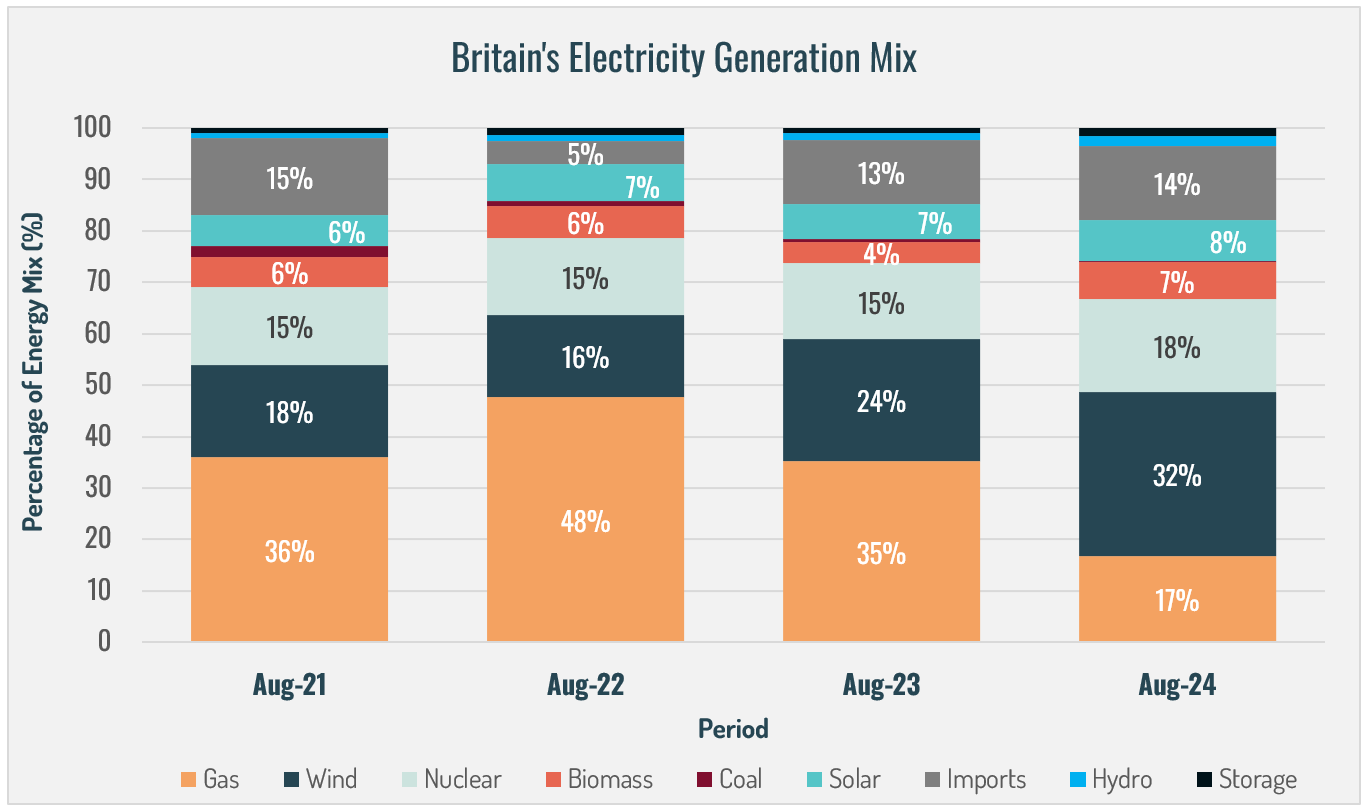
Monthly Statistics
12-Month Rolling (Average) Statistics
To view our interactive renewables map,
click here
Data source: National Grid ESO 2024 (https://www.nationalgrideso.com/electricity-explained/electricity-and-me/great-britains-monthly-electricity-stats)
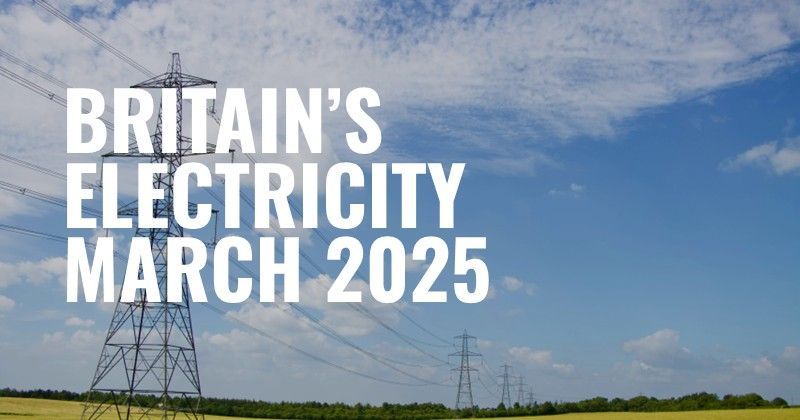
Fuel Type Breakdown In March 2025, gas was the leading source of Britain's electricity generation, contributing 31% of the energy mix, a 7% increase from March 2024. However, this was the second-lowest gas share for March in the last five years. Wind energy accounted for 26%, down 7% from March 2024. Solar contributed 7%, up 3% year-on-year, it's highest contribution for March in the previous five years. Hydro and storage maintained consistent contributions of 3% and 1%, respectively, matching their performance for every March in the last five years. Biomass contributed 5%, the same as March 2024; however, 3% below it's share in March 2021. Coal contributed 0%, following its phase-out in September 2024. For comparison, coal made up 1% of the mix in March 2024. Zero-Carbon Sources & Carbon Intensity Zero-carbon sources delivered 45% of Britain's electricity in March 2025 - 6% lower than March 2024 and the second-lowest March share in the past five years. This decline led to a higher carbon intensity, with emissions at 146 gCO₂/kWh, up 15% from March 2024. The rolling 12-month average for zero-carbon electricity remained at 50%, unchanged from the previous period, indicating stagnation in renewable integration. However, carbon intensity over this 12-month period continues to be the lowest of the past five years, at 127 gCO₂/kWh, and 14% lower than the previous 12-month period. Increasing renewable electricity generation remains crucial to achieving net-zero goals, enhancing energy security, and reducing reliance on imports. Britain's Electricity Summary Charts
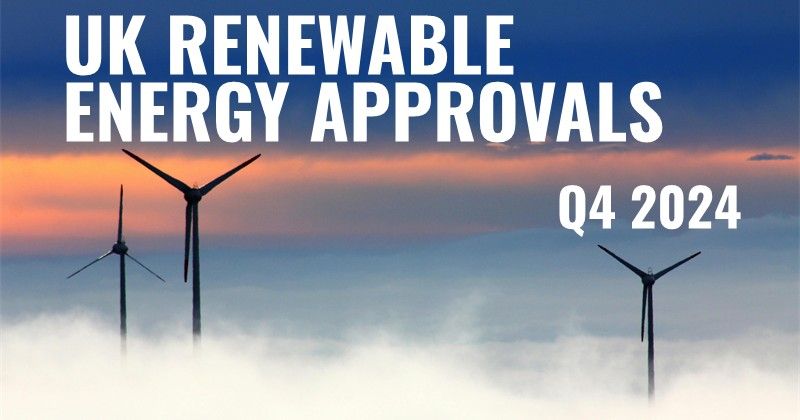
edenseven are following trends in the renewable energy sector closely, as decarbonising the energy sector is vital for ensuring a sustainable future and achieving Net Zero. Considering the recent DESNZ quarterly update of the renewable energy planning database, we have produced a consolidated summary of projects in the United Kingdom that have received planning permission. We will continue to release updates each quarter. INSIGHT In 2024, the UK approved 592 solar PV projects , the third-highest of any year in the last 15 years. However, the energy capacity expected to be delivered by these projects is 24% lower than in 2023. 2024 ranked 11th out of the last 15 years for the total number of onshore wind projects granted planning permission. These projects will deliver the lowest energy capacity for onshore wind approved for any year in the last 15 years, and is down 59% year-on-year. Energy capacity from offshore wind projects granted planning permission in 2024 saw a 62% drop compared to 2023, despite the same number of projects being approved as the prior year. Overall, the total approved renewable energy capacity from wind and solar projects dropped by 43% compared to 2023 , with offshore wind seeing the steepest decline. However, the average capacity per solar PV project increased by 50% , while onshore and offshore wind saw reductions of 63% and 62% , respectively. These findings suggest that we are not implementing wind and solar renewable energy projects quickly enough in the UK to achieve a decarbonised energy network by 2030.
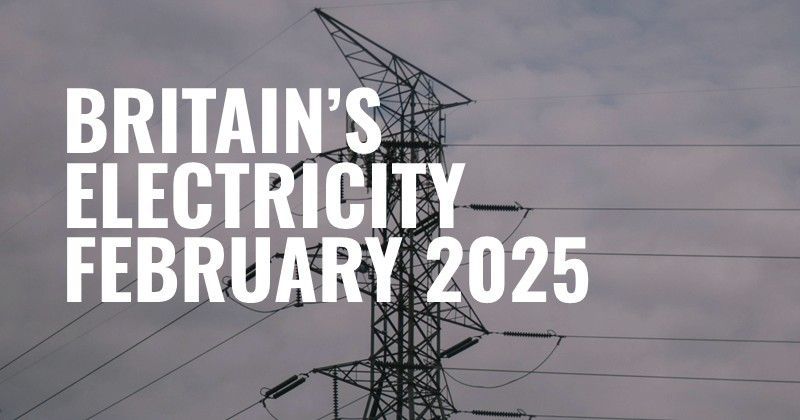
In February 2025, gas accounted for 33% of Britain’s electricity mix, making it the largest contributor, slightly ahead of wind energy, which supplied 32%. This marks a 6% increase in gas-generated electricity and a 3% decline in wind energy compared to February 2024. The highest-ever wind energy contribution for February was recorded in 2022, when it made up 40% of Britain's electricity mix. Solar, biomass, and storage delivered the same contributions as in February 2024, contributing 2%, 7% and 1% respectively. Nuclear energy saw a 1% increase, supplying 12% of Britain's electricity in February 2025 - its highest share for February in the past three years. However, this remains 2% below the levels recorded in February 2021 and 2022. Hydro contributed 2% of Britain’s electricity generation, a 1% decrease from its 3% share in February 2024. Coal, which was phased out of UK electricity generation in September 2024, contributed 0% in February 2025. For comparison, coal accounted for 1% of electricity generation in February 2024. Zero-carbon sources delivered 48% of Britain’s electricity in February 2025, 3% lower than in February 2024 and the third highest for February in the last five years. However, the rolling 12-month average for zero-carbon electricity remains at 50%, the highest of the past five years. The carbon intensity of electricity generation in February 2025 was 147 gCO₂/kWh, 11% higher than in February 2024 and the third highest of the last five years. Despite this, the rolling 12-month average carbon intensity stands at 126 gCO₂/kWh, the lowest in five years and 17% lower than the previous 12-month period. Increasing renewable electricity generation remains crucial to achieving net-zero goals, enhancing energy security, and reducing reliance on imports.

On March 5th, 2025, Sustainability and FM Leaders captured the attention of Business Directors. By signing their Energy Savings Opportunity Scheme (ESOS) Action Plans, they collectively endorsed a strong business case with tangible opportunities to reduce energy consumption and costs, all in preparation for the reporting period ending on December 5th, 2027. Few businesses would dispute the benefits of focusing on energy efficiency. It not only reduces operational costs and enhances profitability but also contributes to decarbonisation efforts - an increasingly important factor for sustainability-conscious employees, customers, and shareholders. Time to Unlock Savings From Your List of ESOS Measures As part of Phase 3, approximately 11,900 UK businesses submitted their ESOS reports in August 2024. These were followed by the required Action Plans on March 5th, 2025. Moving forward, businesses must submit annual progress reports in the final Phase 4 assessment on the December 5th, 2027. The latest government guidance indicates that, instead of using the ESOS portal, companies subject to SECR may "report progress annually via the energy efficiency narrative section in SECR reports." (This flexibility depends on parliamentary time and scrutiny). Regardless of the method, demonstrating effective management of the Action Plan’s implementation is both a regulatory requirement and a best practice." A Business Case Approach to Prioritise Interventions edenseven's extensive experience in supporting customers with ESOS compliance has been overwhelmingly positive. Businesses were given the opportunity to tailor their energy-saving actions to align with their unique needs and strategies. Notably, ESOS guidance doesn't mandate a minimum number of Measures in the Action Plan. However, there is a hint of a reputational impact from September 2025, when the Environment Agency will publish action plans, including of companies that have not committed to any Measure. A well-structured action plan can significantly enhance a company's credibility. Businesses have the flexibility to choose energy-saving initiatives that align with their specific needs, considering factors such as budget, lifecycle assessments, estate strategy, and fleet procurement cycles. By thoughtfully balancing these considerations with broader sustainability goals, companies can achieve meaningful progress while maintaining financial and operational stability. Expertise and Tools to Make it Happen in Phase 4 With Phase 4 of ESOS now fully underway, meticulous planning and well-supported investment decisions are essential. Companies must build robust business cases that integrate technical, regulatory, and financial considerations. In response to this need, edenseven has advanced its cero.earth carbon accounting & management platform by introducing a dynamic Project Forecasting and Management module. Project Forecasting and Management Module cero.earth ’s project tools serve as a comprehensive database of all potential projects, enabling real-time impact analysis, including: Cost and savings projections CO2 emissions reductions Energy Use Intensity improvements These tools enable businesses to forecast the financial costs and benefits of their approved measures within an agreed timeframe. For example, a CFO can review scenario options that highlight the financial and environmental advantages of initiatives such as HVAC retrofitting, solar PV installation, or even building decommissioning. Monitoring Energy Performance for ESOS Requirement Together with SECR Reporting cero.earth is already configured to automatically generate Streamlined Energy and Carbon Reporting (SECR) reports. While the Environment Agency has outlined the content expectations for the December 2025 progress update, formatting requirements remain unspecified. edenseven remains agile in supporting customers with both insights and tools to streamline their reporting. Prepare for the Future with edenseven The transition to a more sustainable business model requires proactive planning and strategic execution. Get in touch today to learn how edenseven can support your journey towards compliance and sustainability excellence.
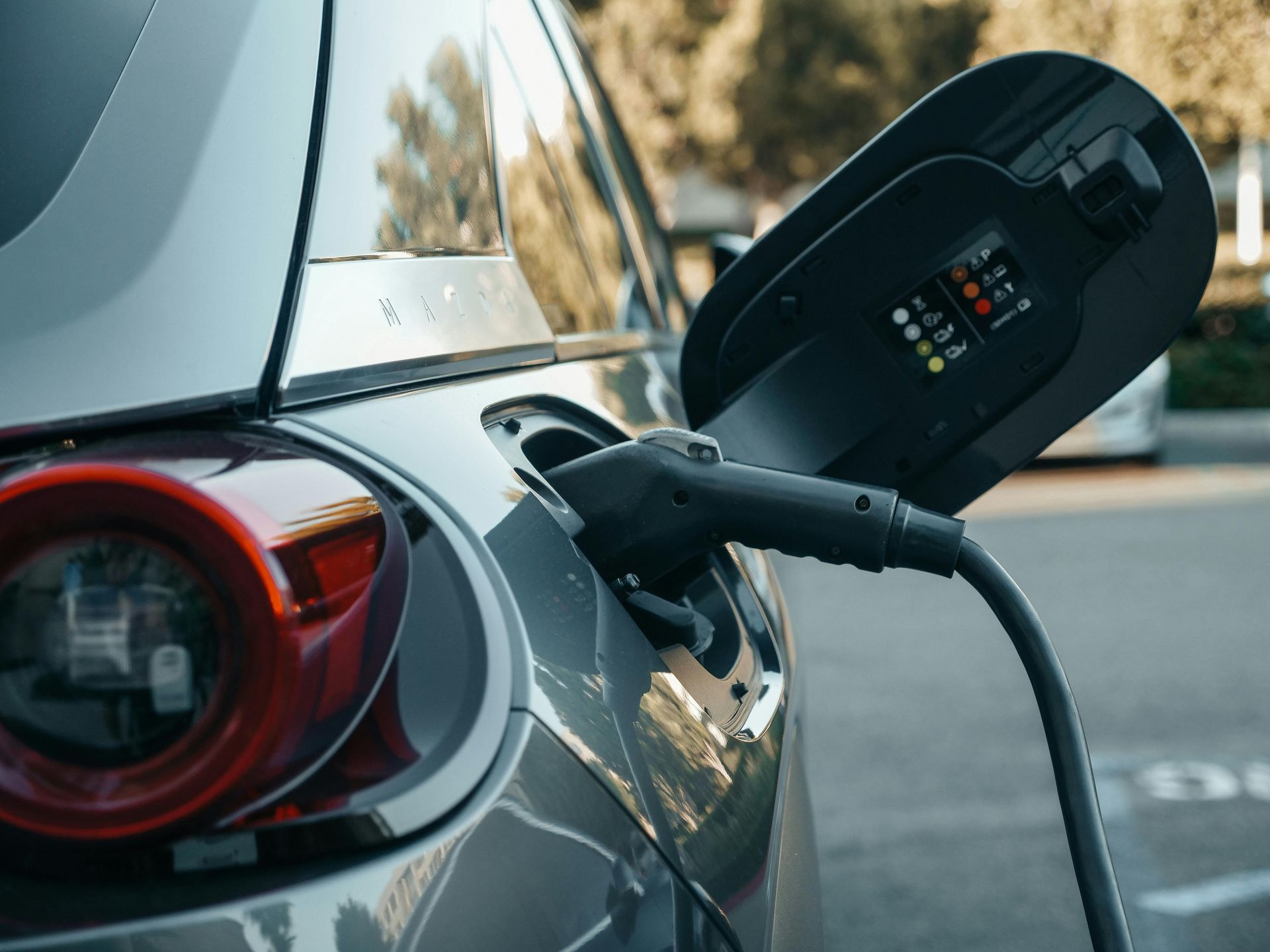
We’re delighted to continue collaborating with Paythru, supporting their commitment to sustainability through comprehensive ESG solutions. Our partnership includes edenseven's in-depth measurement and analysis of their Scope 1, 2, and 3 emissions, alongside strategic guidance to help them achieve their wider sustainability goals. Paythru, a UK-based technology company, specialises in cloud-based payment solutions for electric vehicle (EV) charging and parking. Their innovative platform simplifies the EV payment experience by decoupling the charging process from physical hardware, staying true to their philosophy: "Experience first. Technology second." As part of this ongoing partnership, Paythru is utilising cero.earth , carbon accounting and management platform, to accurately measure, track, and reduce their carbon footprint. ESG reporting goes beyond compliance - it drives real impact. By precisely measuring their environmental footprint, companies can set meaningful targets, monitor progress, and lead tangible change. We, at edenseven, are proud to support Paythru in demonstrating their ongoing commitment to sustainability and shaping a greener future for EV infrastructure.
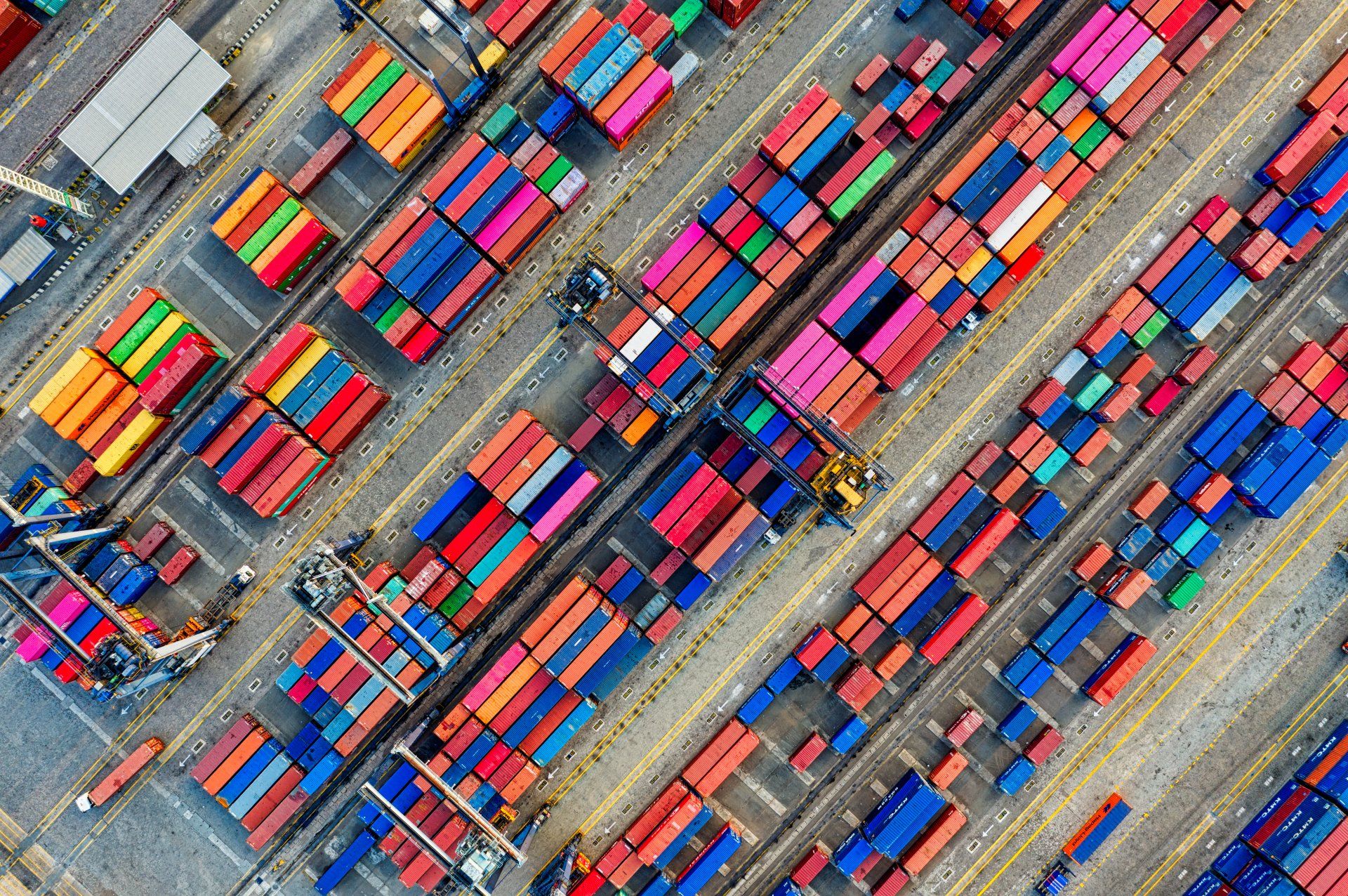
What Do Your Scope 3 Emissions Have to Do with Inflation? Scope 3 emissions cover everything outside your direct operations - the carbon footprint of your supply chain, purchased goods, logistics, business travel, and more. The higher your Scope 3 emissions, the more energy-intensive your supply chain is. And the more energy-intensive your supply chain, the more vulnerable you are to rising costs. Think of it this way: High Production Costs- If your suppliers are heavily dependent on fossil fuels, their production costs are rising fast. Price Volatility- If your supply chain lacks efficiency and resilience, price volatility will hit you harder. Locking in High Costs- If you’re not actively engaging with suppliers to reduce emissions, you’re locking in long-term cost increases that could have been avoided. Without accurate Scope 3 data and a clear engagement strategy , businesses are leaving themselves open to higher prices, lower margins, and greater financial risk . Why Businesses Struggle to Tackle This A major challenge is that Procurement and Sustainability teams often operate in silos: Procurement teams focus on cost and supplier relationships but often lack deep sustainability expertise. Sustainability teams focus on compliance and decarbonisation but aren’t typically measured on financial performance. This disconnect means emissions reduction is rarely treated as a financial opportunity —when in reality, cutting carbon from your supply chain is also one of the most effective ways to reduce exposure to cost inflation. The Businesses That Get This Right Will Win Leading organisations are already taking action. They are: Gathering detailed Scope 3 emissions data to map out cost risks in their supply chain. Engaging suppliers to drive efficiency, reduce emissions, and lower costs. Building resilience by shifting towards lower-carbon, more cost-stable alternatives. The result? Lower long-term costs, reduced financial risk, and a competitive edge over those stuck with inefficient supply chains. This is not just about sustainability compliance —it’s about smart financial decision-making. If You’re Not Taking Action, You’re Losing Money Every business will feel the impact of rising supply chain costs—but not every business will be prepared for them. If you don’t have accurate Scope 3 emissions data and an effective engagement strategy, you are: Paying more than you need to for essential goods and services. Exposing your business to long-term cost inflation. Missing out on opportunities to build a stronger, more resilient supply chain. The sooner you act, the better—for your bottom line and for the planet. Is your business ready to take control of its costs? Get in touch today.

In 2023, the UK Government announced plans to introduce a carbon border tax from 2027, known as the UK Carbon Border Adjustment Mechanism (UK CBAM). This policy aims to prevent carbon leakage (the practice of shifting emissions-intensive production to countries with weaker climate policies) by ensuring that imported goods are subject to a comparable carbon price as those produced domestically under the UK Emissions Trading Scheme (UK ETS). Ultimately, the goal is to drive global reductions in industrial emissions and support the transition to a low-carbon economy. What is the UK CBAM? The UK CBAM will apply to imported goods in emissions-intensive industries. Starting in 2027, businesses importing iron, steel, aluminium, ceramics, cement, fertilisers, glass and hydrogen into the UK will be required to: Mandatory Disclosures: Submit reports detailing the carbon emissions embedded in their products (embodied carbon). The UK CBAM will require reporting to detail the Scope 1 (direct emissions from production), Scope 2 (indirect emissions from purchased electricity), and select precursor product emissions embodied in imported products. Levy Payments: Pay a levy based on the carbon pricing of the exporting country. If the exporting country has little to no carbon pricing, UK importers will be subject to a higher tax rate. This initiative encourages businesses to source materials from suppliers with strong carbon policies, incentivising sustainable production methods. How Will it Work? The UK CBAM will require importers to report and pay for the emissions embedded in their products at the UK ETS carbon price. If a foreign producer has already paid a carbon price in the country of manufacture, this may be deducted from the payment charge under UK CBAM to avoid double taxation. The UK Government has proposed to have four accounting periods per year to align with the standard practices used by other taxes. How Does the UK CBAM Differ from the EU CBAM? While both mechanisms share the same overarching objectives, there are key differences: Scope of Products : The EU CBAM applies to cement, iron, steel, aluminium, fertilisers, electricity and hydrogen, whereas the UK CBAM excludes electricity imports but also applies to additional products, such as ceramics and glass Implementation Timeline : The EU CBAM has already begun its transitional phase (October 1, 2023), requiring emissions reporting, with full financial enforcement starting in 2026. The UK CBAM, however, will take effect in 2027. What Can Businesses Do to Prepare? To limit exposure and ensure compliance with UK CBAM, businesses should take the following steps: Assess Supply Chains: Assess your exposure to UK CBAM by reviewing your suppliers to understand where imported products and materials are being manufactured and their carbon intensity. Identify other suppliers with lower-carbon intensities. Engage Key Suppliers: Work with your suppliers to encourage the adoption of low-carbon technologies and practices that will reduce the carbon intensity of manufactured materials. Consider switching suppliers and sourcing materials from UK-based companies that already comply with UK ETS, to reduce exposure. Comprehensive Emissions Reporting: Ensure you have sufficient emissions accounting and reporting practices in place, to minimise disruption caused by mandatory reporting. We recommend businesses understand their Scope 1, 2 & 3 emissions to identify high-impact activities and inefficiencies within their operations and their supply-chain. How We Can Help edenseven is a sustainability consultancy with a proven track record in designing and delivering data-driven sustainability strategies. Our cloud-based carbon accounting and management platform, cero.earth , simplifies compliance and reporting for businesses of all sizes. Why Choose cero.earth? Regulatory Compliance: Aligns with the Greenhouse Gas Protocol (Scope 1, 2 & 3) to ensure accurate and compliant carbon reporting. Expert Support: Backed by a team of analysts who guide you through the process, making compliance straightforward. Seamless Data Integration: Easily upload and export data in required formats with our integrated report building tools, for effortless reporting and disclosure. Enhanced Credibility: Track and disclose detailed emissions data to investors and stakeholders with confidence, ensuring enhanced credibility. Reduce Costs: cero.earth identifies high emissions sources and inefficiencies within your operations and supply chain, enabling you to make informed decisions about where to implement impactful change, saving you cost with CBAM and ongoing operations. Net Zero Project Tracking: Design, implement and track your carbon-reduction projects and leverage our Net Zero Carbon (NZC) dashboard to visualize your pathway to Net Zero and set strategic carbon reduction targets. Flexible Packages: cero.earth offers tailored packages to suit all businesses. For businesses seeking a hands-off experience, our Strategic package allows us to handle the entire carbon accounting and compliance process on your behalf, ensuring a seamless and fully managed approach, allowing you to focus on what you do best. Prepare Your Business for the Future With the UK CBAM on the horizon, businesses must take proactive steps to manage their carbon impact and ensure compliance. cero.earth by edenseven, provides the tools and expertise needed to navigate these changes with ease. Start your journey towards sustainable and compliant operations today. Get in touch today to learn more about how we can support your transition and comply with the latest sustainability regulations.

Over the last few decades, carbon offsetting has become a go-to strategy for businesses looking to demonstrate sustainability commitments and enhance their external credibility. Offsetting takes many forms, from tree planting and forest conservation to providing communities with clean cookstoves and renewable energy. However, with a vast number of offset providers offering projects of varying credibility, navigating this landscape can be confusing for businesses and consumers alike. The Problem with Offsetting While carbon offsetting can play a role in broader climate action, it is not a substitute for direct emissions reductions. Protecting and enhancing nature and biodiversity should be seen as complementary to carbon reduction—not a replacement for it. Lack of Additionality - Many offsetting projects do not actually remove additional carbon from the atmosphere beyond what would have happened anyway. Distraction from True Action - Offsetting can divert attention from the urgent need to tackle emissions at the source, delaying meaningful business-wide carbon reductions. Regulatory and Reputational Risks - The EU is set to ban terms like "climate/carbon neutral" or "climate positive" based on offsetting from 2026, increasing the risk of greenwashing accusations for businesses wishing to claim climate positives from offsetting projects. Several large companies have already rolled back offset-based sustainability claims after using unreliable carbon offsets. Should you Avoid Offsetting Entirely? Not necessarily. High-quality carbon offsets can still be a useful tool to support broader sustainability efforts, and often provide social benefits, while supporting the United Nations Sustainable Development Goals (SDGs). However, they should only come after a business has taken concrete steps to measure and reduce emissions. The Science-Based Targets initiative (SBTi), a leading assessor of corporate science-based Net Zero targets, only permits the offsetting of residual, unavoidable emissions (less than 10% of a company's total emissions) after all other feasible reduction measures have been implemented. This further highlights the importance of prioritsing direct emissions reductions before considering any forms of offsetting. Before investing in offsets, ensure you: Measure Your Carbon Footprint - This should include Scope 1, 2 and 3 emissions, to provide a full picture of your environmental impact. Without this data, you are unable to make informed carbon reductions. Develop a Robust Carbon Reduction Plan - Your plan should cover Scope 1, 2 and 3, align with the goals of the Paris Agreement, and set ambitious reduction targets. Take Action and Track Progress - Implement emissions reduction initiatives and continuously monitor progress towards Net Zero. If your business meets these criteria, investing in credible, high-quality offsetting schemes can be an additional way to contribute to climate action. However, if these foundational steps are not in place, offsetting alone is not the answer for your business - it does little to drive real change. What We Offer At edenseven, we help businesses design and implement data-driven sustainability strategies that prioritise real emissions reductions. Our cloud-based platform, cero.earth , simplifies carbon accounting and management, ensuring compliance with climate regulations and providing a clear roadmap to Net Zero. With expert guidance from edenseven, your business can avoid greenwashing pitfalls and take meaningful action to cut emissions, comply with regulations, ensure credibility with stakeholders, and reduce costs. Want to build a credible, impactful sustainability strategy? Get in touch today.
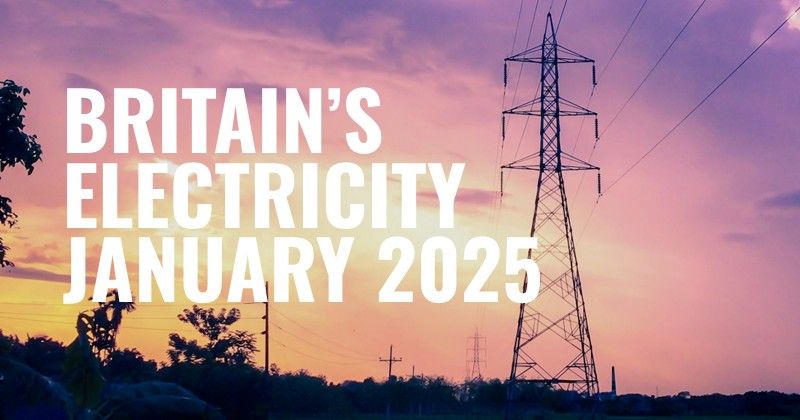
In January 2025 , gas accounted for 38% of Britain’s electricity mix, the highest contribution among all sources. This represented an 11% lead over wind energy and a 2% increase compared to January 2024. Wind energy, however, delivered its lowest January contribution in the past four years, comprising 27% of the energy mix. Nuclear and imports each saw a 3% increase, contributing 12% of Britain’s electricity generation. Contributions from solar, hydro, and biomass remained stable compared to January 2024, with solar and hydro each accounting for 2% and biomass 6%. Coal, which was phased out of UK electricity generation in September 2024, delivered 0% of electricity in January 2025. For comparison, coal contributed 2% in January 2024, equal to the individual shares of solar and hydro. Zero-carbon sources made up 43% of Britain’s electricity generation in January 2025 - the lowest proportion for January in the past four years. This was 4% lower than in January 2024 and 13% lower than January 2023. However, the rolling 12-month average for zero-carbon sources reached 51%, the highest of the past four years and 2% higher than the previous 12-month period. The carbon intensity of electricity generation in January 2025 was 168 gCO₂/kWh, the second highest of the past four years. Despite this, the rolling 12-month average carbon intensity fell to 125 gCO₂/kWh - a 19% reduction compared to the prior year and the lowest of the past four years, underscoring progress in decarbonisation. Increasing renewable electricity generation remains crucial to achieving net-zero goals, enhancing energy security, and reducing reliance on imports.

Contributing Authors: Pete Nisbet, Alejandro Navarro, Craig Cheney In their 2020 report, the Climate Change Committee emphasised the importance of local authorities in national decarbonisation efforts and the UK’s journey to net zero. Quoting the capacity to impact roughly one third of UK emissions, the report highlighted the significant remit of local authorities, including local transport, social housing, and waste, as well as their influence over local businesses and communities. Unlike private entities and businesses – which also contribute significantly to UK emissions yet often exhibit limited willingness to respond* – local authorities have demonstrated a clear commitment to addressing climate change. Out of 394 local authorities, 327 have declared a climate emergency, with 114 setting net-zero targets and 280 developing actionable plans. This highlights the readiness of local authorities to act; however, translating this enthusiasm into meaningful outcomes requires clearer direction and support from central government. While the new government has shown a willingness to address these challenges, the reality is that news policies and funding mechanisms take time to develop and implement. Bridging this gap between ambition and action will be crucial to unlocking the full potential of local authorities in driving the UK’s net-zero agenda. One stand-out and wide-reaching solution to this is climate technology . With the ability to process data more effectively, identify problems faster, and test solutions virtually, technology provides an efficient, transformative vessel for decarbonisation and net zero strategies. In a recent survey, 40% of senior executives said they believe that digital technologies are already having a positive impact on their sustainability goals. And, with the ability to initiate significant carbon reductions across energy, materials, and mobility, and save money at the same time, climate tech has the potential to provide the public sector with the resources it needs toward net zero. *According to our recent analysis of the FTSE 250, 41% of the FTSE 250 do not have a net zero target, and those who do have delayed it by an average of 13 months.



